Huawei Technologies RTN360R6 Radio Transmission System User Manual Compliance and Safety Manual
Huawei Technologies Co.,Ltd Radio Transmission System Compliance and Safety Manual
Contents
- 1. Users Manual
- 2. Compliance and Safety Manual
- 3. Quick Installation Guide
- 4. Regulatory Compliance Statement
Compliance and Safety Manual

OptiX RTN 360 Radio Transmission System
V100R001
Compliance and Safety Manual
Issue
02
Date
2014-08-30
HUAWEI TECHNOLOGIES CO., LTD.

Issue 02 (2014-08-30)
Huawei Proprietary and Confidential
Copyright © Huawei Technologies Co., Ltd.
i
Copyright © Huawei Technologies Co., Ltd. 2014. All rights reserved.
No part of this document may be reproduced or transmitted in any form or by any means without prior
written consent of Huawei Technologies Co., Ltd.
Trademarks and Permissions
and other Huawei trademarks are trademarks of Huawei Technologies Co., Ltd.
All other trademarks and trade names mentioned in this document are the property of their respective
holders.
Notice
The purchased products, services and features are stipulated by the contract made between Huawei and
the customer. All or part of the products, services and features described in this document may not be
within the purchase scope or the usage scope. Unless otherwise specified in the contract, all statements,
information, and recommendations in this document are provided "AS IS" without warranties, guarantees or
representations of any kind, either express or implied.
The information in this document is subject to change without notice. Every effort has been made in the
preparation of this document to ensure accuracy of the contents, but all statements, information, and
recommendations in this document do not constitute a warranty of any kind, express or implied.
Huawei Technologies Co., Ltd.
Address:
Huawei Industrial Base
Bantian, Longgang
Shenzhen 518129
People's Republic of China
Website:
http://www.huawei.com
Email:
support@huawei.com

OptiX RTN 360 Radio Transmission System
Compliance and Safety Manual
About This Document
Issue 02 (2014-08-30)
Huawei Proprietary and Confidential
Copyright © Huawei Technologies Co., Ltd.
ii
About This Document
Purpose
This document describes the compliance of the OptiX RTN 360 with Electromagnetic
Compatibility (EMC) and other safety standards, and provides general safety guidelines for
handling, installing or operating the OptiX RTN 360.
Intended Audience
This document is intended for:
Technical support engineers
Installation engineers
Maintenance engineers
Network planning engineers
Attention
Before installing or operating on equipment, read the symbol conventions and safety
information to ensure safety and security in the related operations.

OptiX RTN 360 Radio Transmission System
Compliance and Safety Manual
Contents
Issue 02 (2014-08-30)
Huawei Proprietary and Confidential
Copyright © Huawei Technologies Co., Ltd.
iii
Contents
About This Document .................................................................................................................... ii
1 Regulatory Compliance Statement ............................................................................................ 1
1.1 European Community CE Certification DoC ............................................................................................................... 2
2 Regulatory Compliance Information ........................................................................................ 3
2.1 Regulatory Compliance Standards ................................................................................................................................ 3
2.2 European Directives Compliance ................................................................................................................................. 5
2.3 CISPR 22 Compliance .................................................................................................................................................. 5
2.4 USA Regulatory Compliance ........................................................................................................................................ 6
2.4.1 FCC Part 15 ............................................................................................................................................................... 6
2.5 Canada Regulatory Compliance ................................................................................................................................... 6
2.5.1 RSS-Gen statement .................................................................................................................................................... 6
2.5.2 RSS-210 statement: ................................................................................................................................................... 7
2.6 Other Markets ............................................................................................................................................................... 7
3 Safety ............................................................................................................................................... 8
3.1 Health and Safety .......................................................................................................................................................... 8
3.1.1 Overview ................................................................................................................................................................... 8
3.1.2 Electrical Safety ....................................................................................................................................................... 10
3.1.3 Inflammable Environment ....................................................................................................................................... 11
3.1.4 Battery ..................................................................................................................................................................... 12
3.1.5 Radiation .................................................................................................................................................................. 14
3.1.6 Working at Heights .................................................................................................................................................. 14
3.1.7 Mechanical Safety ................................................................................................................................................... 16
3.1.8 Bundling Signal Cables ........................................................................................................................................... 17
3.2 Equipment Safety ........................................................................................................................................................ 17
3.2.1 Electricity Safety ..................................................................................................................................................... 17
3.2.2 Electrostatic Discharge ............................................................................................................................................ 17
3.2.3 Laying Cables .......................................................................................................................................................... 18
3.3 Electromagnetic Field Exposure ................................................................................................................................. 19

OptiX RTN 360 Radio Transmission System
Compliance and Safety Manual
1 Regulatory Compliance Statement
Issue 02 (2014-08-30)
Huawei Proprietary and Confidential
Copyright © Huawei Technologies Co., Ltd.
1
1 Regulatory Compliance Statement
About This Chapter
1.1 European Community CE Certification DoC
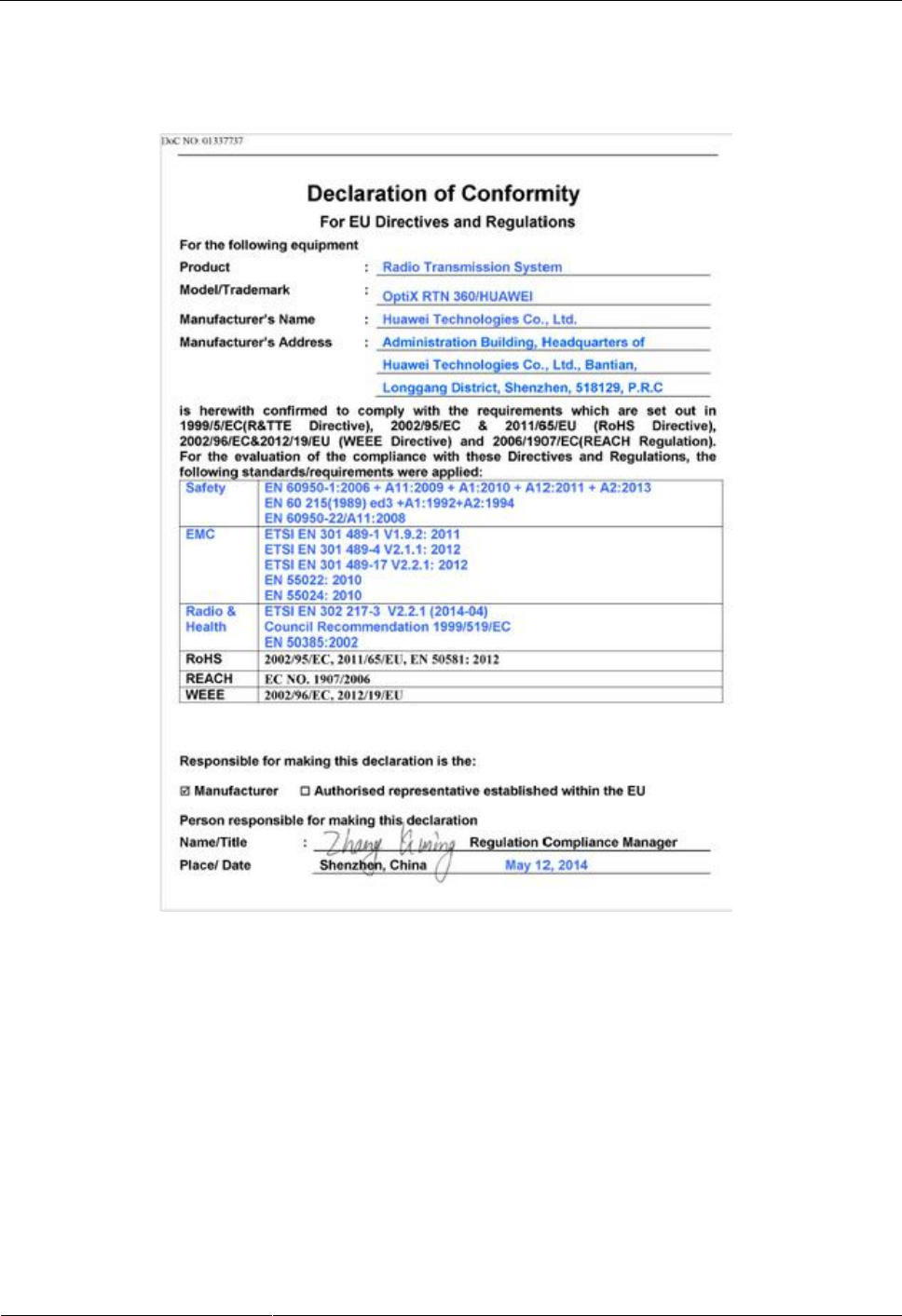
OptiX RTN 360 Radio Transmission System
Compliance and Safety Manual
1 Regulatory Compliance Statement
Issue 02 (2014-08-30)
Huawei Proprietary and Confidential
Copyright © Huawei Technologies Co., Ltd.
2
1.1 European Community CE Certification DoC
Figure 1-1 European community CE certification DoC

OptiX RTN 360 Radio Transmission System
Compliance and Safety Manual
2 Regulatory Compliance Information
Issue 02 (2014-08-30)
Huawei Proprietary and Confidential
Copyright © Huawei Technologies Co., Ltd.
3
2 Regulatory Compliance Information
About This Chapter
2.1 Regulatory Compliance Standards
2.2 European Directives Compliance
2.3 CISPR 22 Compliance
2.4 USA Regulatory Compliance
2.5 Canada Regulatory Compliance
2.6 Other Markets
2.1 Regulatory Compliance Standards
Product complies with the standards listed in Table 2-1.
Table 2-1 Regulatory compliance standards
Discipline
Standards
EMC
EN 55022 Class B
CISPR22 Class B
CISPR 24
EN 50024
ETSI EN 301 489–1
ETSI EN 301 489–4
ETSI EN 301 489–17
VCCI V-3 Class B
ICES-003 Issue 5 Class B
CAN/CSA CISPR 22 Class B
AS/NZS CISPR22 Class B
IEC 61000-6-1
EN 60000-6-1

OptiX RTN 360 Radio Transmission System
Compliance and Safety Manual
2 Regulatory Compliance Information
Issue 02 (2014-08-30)
Huawei Proprietary and Confidential
Copyright © Huawei Technologies Co., Ltd.
4
Discipline
Standards
IEC 61000-6-3
EN 61000-6-3
FCC CFR47
Safety
IEC 60950-1
IEC 60950-22
EN 60950-1
EN 60950-22
IEC 60215
EN 60215
UL 60950-1
UL 60950-22
CSA C22.2 No. 60950-1
CSA C22.2 No. 60950-22
RF
EN 302 217-2-3
FCC CFR47
RSS-Gen
RSS-210
Health
1999-519-EC
EN 50385
Environmental protection
2002/95/EC & 2011/65/EU (RoHS)
EC NO. 1907/2006 (REACH)
2002/96/EC (WEEE)
NOTE
EMC: electromagnetic compatibility
RF: radio frequency
CISPR: International Special Committee on Radio Interference
EN: European Standard
EU: European Union
ETSI: European Telecommunications Standards Institute
IEC: International Electrotechnical Commission
AS/NZS: Australian/New Zealand Standard
VCCI: Voluntary Control Council for Interference
FCC: Federal Communications Commission
CSA: Canadian Standards Association
RoHS: restriction of the use of certain hazardous substances
REACH: Registration, Evaluation, Authorization and Restriction of Chemicals
WEEE: waste electrical and electronic equipment

OptiX RTN 360 Radio Transmission System
Compliance and Safety Manual
2 Regulatory Compliance Information
Issue 02 (2014-08-30)
Huawei Proprietary and Confidential
Copyright © Huawei Technologies Co., Ltd.
5
2.2 European Directives Compliance
OptiX RTN 360complies with the following European directives and regulations..
2004/108/EC (EMC)
2006/95/EC (low voltage)
1999/5/EC (R&TTE)
2002/95/EC & 2011/65/EU (RoHS)
EC NO. 1907/2006 (REACH)
2002/96/EC (WEEE)
OptiX RTN 360complies with Directive 2002/95/EC, 2011/65/EU and other similar
regulations from the countries outside the European Union, on the RoHS in electrical and
electronic equipment. The device does not contain lead, mercury, cadmium, and hexavalent
chromium and brominated flame retardants (polybrominated biphenyls (PBB) or
polybrominated diphenyl ethers (PBDE)) except for those exempted applications allowed by
RoHS directive for technical reasons.
OptiX RTN 360 complies with Regulation EC NO. 1907/2006 (REACH) and other similar
regulations from the countries outside the European Union. Huawei will notify to the
European Chemical Agency (ECHA) or the customer when necessary and regulation requires.
OptiX RTN 360 complies with Directive 2002/96/EC on waste electrical and electronic
equipment (WEEE). Huawei is responsible for recycling its end-of-life devices, and please
contact Huawei local service center when recycling is required. Huawei strictly complies with
the EU Waste Electrical and Electronic Equipment Directive (WEEE Directive) and electronic
waste management regulations enacted by different countries worldwide. In addition, Huawei
has established a system for recycling and reuse of electronic wastes, and it can provide
service of dismantling and recycling for WEEE. By Huawei recycling system, the waste can
be handled environmentally and the resource can be recycled and reused fully, which is also
Huawei WEEE stratagem in the word. Most of the materials in product are recyclable, and our
packaging is designed to be recycled and should be handled in accordance with your local
recycling policies.
In accordance with Article 11(2) in Directive 2002/96/EC (WEEE), products were marked
with the following symbol: a cross-out wheeled waste bin with a bar beneath as below:
2.3 CISPR 22 Compliance
OptiX RTN 360 complies with CISPR 22 Class B.

OptiX RTN 360 Radio Transmission System
Compliance and Safety Manual
2 Regulatory Compliance Information
Issue 02 (2014-08-30)
Huawei Proprietary and Confidential
Copyright © Huawei Technologies Co., Ltd.
6
2.4 USA Regulatory Compliance
2.4.1 FCC Part 15
This device complies with Part 15 of the FCC Rules. Operation is subject to the following two
conditions:
This device does not cause harmful interference.
This device must accept any interference received, including interference that may cause
undesired operation.
If this device is modified without authorization from Huawei, the device may no longer
comply with FCC requirements for Class B digital devices. In that a case, your right to use the
device may be limited by FCC regulations. Moreover, you may be required to correct any
interference to radio or television communications at your own expense.
This device has been tested and found to comply with the limits for a Class B digital device,
pursuant to Part 15 of the FCC rules. These limits are designed to provide reasonable
protection against harmful interference in a residential installation.
This device generates, uses and radiates radio frequency energy. If it is not installed and used
in accordance with the instructions, it may cause harmful interference to radio
communications.
However, there is no guarantee that interference will not occur in a particular installation. If
this device does cause harmful interference to radio or television reception, which can be
determined by turning the device off and on, the user may take one or more of the following
measures:
Reorient or relocate the receiving antenna.
Reinforce the separation between the device and receiver.
Connect the device into an outlet on a circuit different from that to which the receiver is
connected.
Consult the dealer or an experienced radio or TV technician for assistance.
2.5 Canada Regulatory Compliance
2.5.1 RSS-Gen statement
This device complies with Industry Canada licence-exempt RSS standard(s).
Operation is subject to the following two conditions: (1) this device may not cause
interference, and (2) this device must accept any interference, including interference that may
cause undesired operation of the device.
Le présent appareil est conforme aux CNR d'Industrie Canada applicables aux appareils radio
exempts de licence. L'exploitation est autorisée aux deux conditions suivantes : (1) l'appareil
ne doit pas produire de brouillage, et (2) l'utilisateur de l'appareil doit accepter tout brouillage
radioélectrique subi, même si le brouillage est susceptible d'en compromettre le
fonctionnement.

OptiX RTN 360 Radio Transmission System
Compliance and Safety Manual
2 Regulatory Compliance Information
Issue 02 (2014-08-30)
Huawei Proprietary and Confidential
Copyright © Huawei Technologies Co., Ltd.
7
2.5.2 RSS-210 statement:
This device complies with Industry Canada RSS-210. Operation is subject to the following
two conditions: (1) this device may not cause interference, and(2) this device must accept any
interference, including interference that may cause undesired operation of the device.
Le présent appareil est conforme aux CNR d'Industrie Canada applicables aux appareils radio
RSS-210. L'exploitation est autorisée aux deux conditions suivantes : (1) l'appareil ne doit pas
produire de brouillage, et (2) l'utilisateur de l'appareil doit accepter tout brouillage radioé
lectrique subi, même si le brouillage est susceptible d'en compromettre le fonctionnement.
2.6 Other Markets
For relevant compliance information/documentation for markets not mentioned above, please
contact Huawei representative.

OptiX RTN 360 Radio Transmission System
Compliance and Safety Manual
3 Safety
Issue 02 (2014-08-30)
Huawei Proprietary and Confidential
Copyright © Huawei Technologies Co., Ltd.
8
3 Safety
About This Chapter
3.1 Health and Safety
3.2 Equipment Safety
3.3 Electromagnetic Field Exposure
3.1 Health and Safety
3.1.1 Overview
Introduction
This section describes the safety precautions you must take before installing or maintaining
Huawei equipment.
To ensure safety of humans and the equipment, pay attention to the safety symbols on the
equipment and all the safety instructions in this document.
The "NOTE", "CAUTION", and "WARNING" marks in other documents do not
represent all the safety instructions. They are only supplements to the safety instructions.
Installation and maintenance personnel must understand basic safety precautions to avoid
hazards.
When operating Huawei equipment, in addition to following the general precautions in
this document, follow the specific safety instructions given by Huawei.
Only trained and qualified personnel are allowed to install, operate, and maintain Huawei
equipment.
Local Safety Regulations
When operating Huawei equipment, you must follow the local laws and regulations. The
safety instructions in this document are only supplements to the local laws and regulations.

OptiX RTN 360 Radio Transmission System
Compliance and Safety Manual
3 Safety
Issue 02 (2014-08-30)
Huawei Proprietary and Confidential
Copyright © Huawei Technologies Co., Ltd.
9
General Requirements
To minimize risk of personal injury and damage to equipment, read and follow all the
precautions in this document before performing any installation or maintenance.
Ensure that the instructions provided in this document are followed completely. This section
also provides guidelines for selecting the measuring and testing devices.
Installation
The device (or system) must be installed in an access-controlled location.
When installing the unit, always make the ground connection first and disconnect it at
the end.
Do not block the ventilation while the device is operating. Keep a minimum distance of 5
cm between the device and the wall or other objects that may block the ventilation.
Ground
Do not damage the ground conductor or operate the device in the absence of a properly
installed ground conductor. Conduct the electrical inspection carefully.
The device (or system) must be connected permanently to the protection ground before
an operation. The cross-sectional area of the protective ground conductor must be at least
0.75 mm2.
Power Supply
For DC-supplied model: The device applies to DC power source that complies with the
Safety Extra-Low Voltage (SELV) requirements in IEC 60950-1 based safety standards.
Prepared conductors are connected to the terminal block, and only the appropriate
AWG/Type of wire is secured with the lug terminals.
Short-circuit (overcurrent) protection of the device varies according to the building's
installation. Ensure that a fuse or circuit breaker no larger than 120 VAC, 15 A U.S. (240
VAC, 10 A international) for AC-supplied model or 80 VDC, 32 A for DC-supplied
model is used on the phase conductors (all current-carrying conductors).
Human Safety
Do not wear jewelry or watches when you operate the device.
Operator
Only qualified professional personnel are allowed to install, configure, operate, and
disassemble the device.
Only the personnel authenticated or authorized by Huawei are allowed to replace or
change the device of the parts of the device (including the software).
Any fault or error that might cause safety problems must be reported immediately to a
supervisor.
Only qualified personnel are allowed to remove or disable the safety facilities and to
troubleshoot and maintain the device.
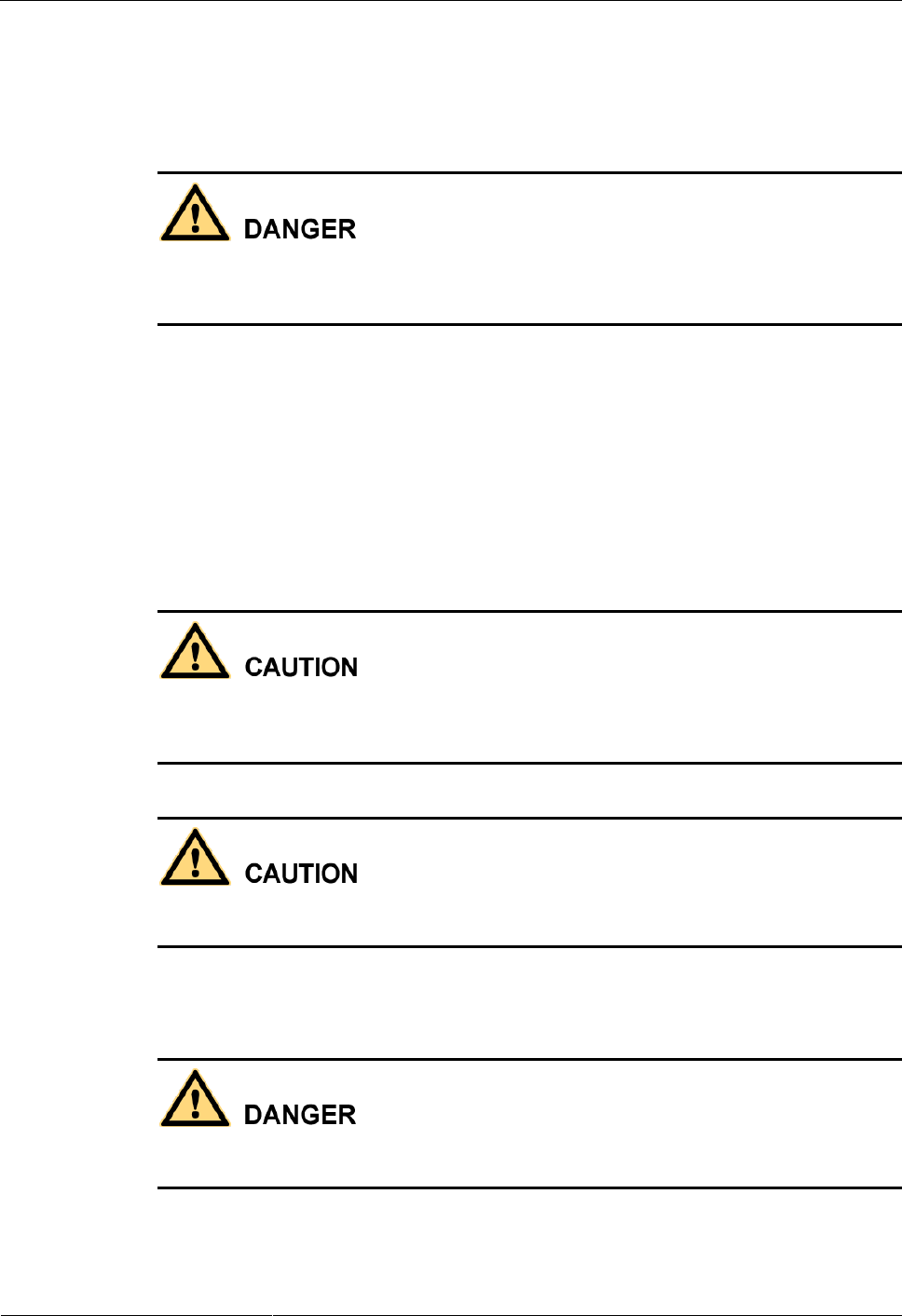
OptiX RTN 360 Radio Transmission System
Compliance and Safety Manual
3 Safety
Issue 02 (2014-08-30)
Huawei Proprietary and Confidential
Copyright © Huawei Technologies Co., Ltd.
10
3.1.2 Electrical Safety
High Voltage
The high voltage power supply provides power for the device operation. Direct or indirect
contact (through damp objects) with high voltage and AC mains supply may result in fatal
danger.
During the installation of the AC power supply facility, follow the local safety
regulations. The personnel who install the AC facility must be qualified to perform high
voltage and AC operations.
Do not wear conductive articles, such as watches, hand chains, bracelets, and rings
during the operation.
When water is found in the rack or the rack is damp, switch off the power supply
immediately.
When the operation is performed in a damp environment, make sure that the device is
dry.
Non-standard and improper high voltage operations may result in fire and electric shock.
Therefore, you must abide by the local rules and regulations when bridging and wiring AC
cables. Only qualified personnel are allowed to perform high voltage and AC operations.
Before powering on a device, ground the device. Otherwise, personal injury or device damage
may be caused by high leakage current.
Thunderstorm
Do not perform any operation, including high voltage and AC operations, on a steel tower or
mast during a thunderstorm.
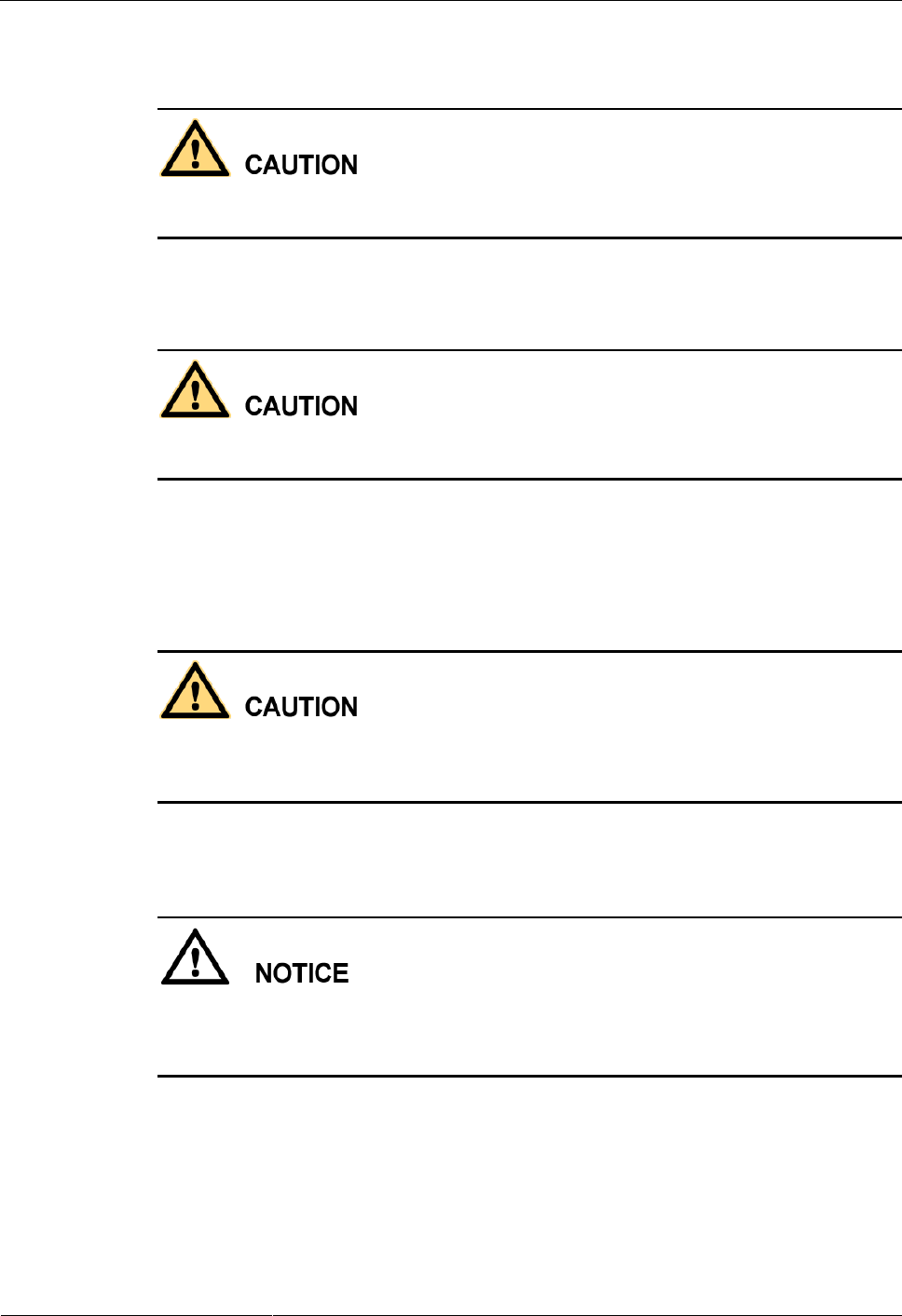
OptiX RTN 360 Radio Transmission System
Compliance and Safety Manual
3 Safety
Issue 02 (2014-08-30)
Huawei Proprietary and Confidential
Copyright © Huawei Technologies Co., Ltd.
11
Tools
Dedicated tools must be used during high voltage and AC operations. Avoid using ordinary
tools.
High Electrical Leakage
Ground the device before powering it on. Otherwise, personal injury or device damage may
be caused by high leakage current.
If a "high electrical leakage" tag is present on the power terminal of the device, you must
ground the device before powering it on.
Power Cable
Do not install or remove power cables when the device is on. Transient contact between the
core of the power cable and the conductor may generate electric arcs or sparks, which may
cause fire or hurt human eyes.
Before installing or removing the power cable, turn off the power switch.
Before connecting a power cable, check that the label on the power cable is correct.
If the device is connected with the DC power supply, use 0.75 mm² or 18 AWG minimum
power supply cord.
Use type H03VV-F or light PVC-sheathed flexible cord according to IEC 60227.
3.1.3 Inflammable Environment
Operating the electrical device in an inflammable environment can be fatal.
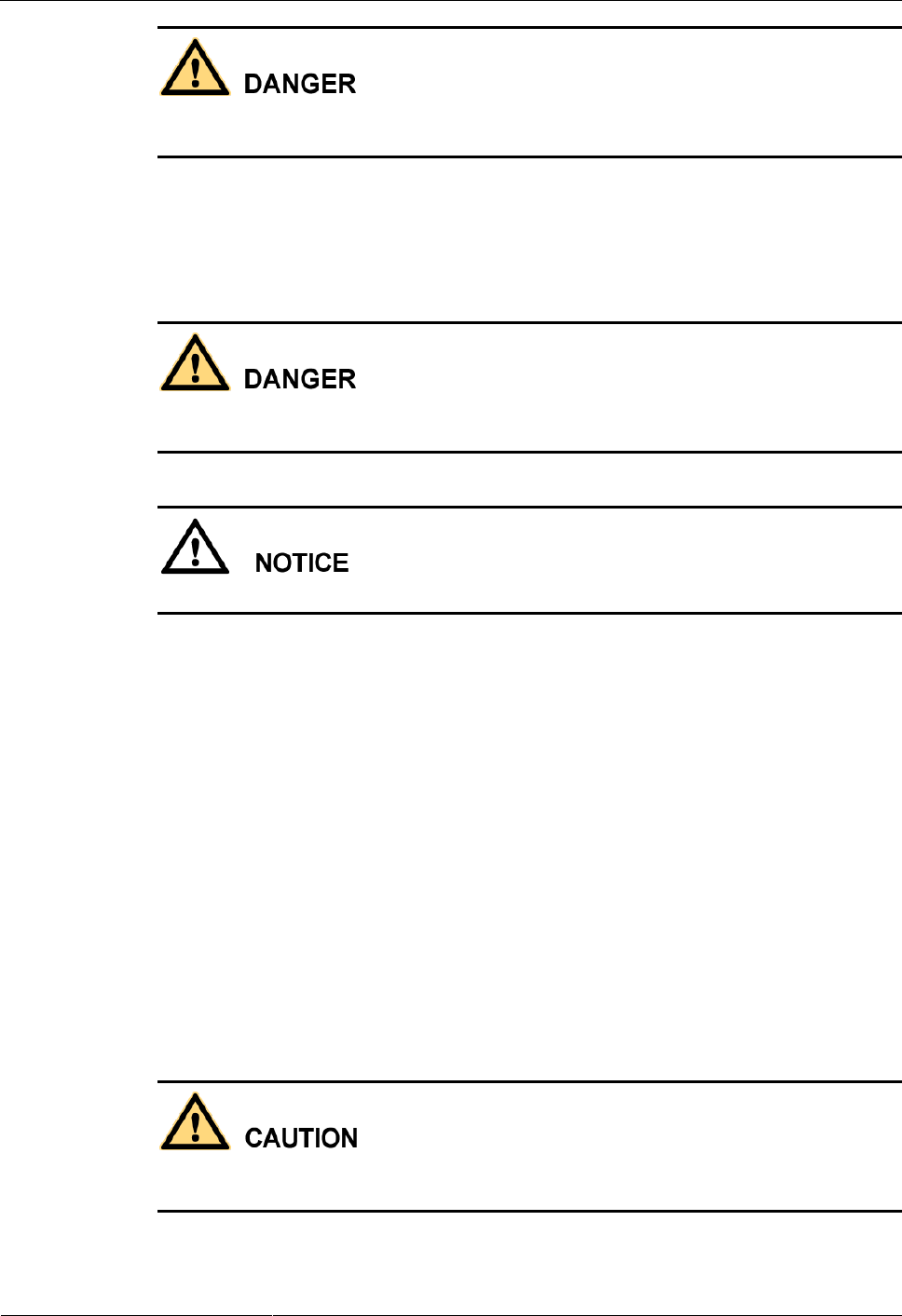
OptiX RTN 360 Radio Transmission System
Compliance and Safety Manual
3 Safety
Issue 02 (2014-08-30)
Huawei Proprietary and Confidential
Copyright © Huawei Technologies Co., Ltd.
12
Do not place the device in an environment that has inflammable and explosive air or gas. Do
not perform any operation in this environment.
3.1.4 Battery
Storage Battery
Before operating storage batteries, carefully read the safety precautions for battery handling
and connection.
Improper handling of storage batteries causes hazards.
When operating storage batteries, avoid short circuit and overflow or leakage of the
electrolyte. Electrolyte overflow may damage the device. It will corrode metal parts and
circuit boards, and ultimately damage the device and cause short circuit of circuit boards.
Basic Precautions
Before installing and maintaining the battery, note the following:
Do not wear metal articles such as wristwatch, hand chain, bracelet, and ring.
Use special insulation tools.
Take care to protect your eyes when operating the device.
Wear rubber gloves and a protective coat in case of electrolyte overflow.
When handling a storage battery, ensure that its electrodes are upward. Leaning or
reversing the storage battery is prohibited.
Short Circuit
Battery short circuit may cause human injuries. Although the voltage of ordinary batteries is
low, the instantaneous high current caused by the short circuit releases a great deal of energy.
There is danger of explosion if the battery is incorrectly replaced. Therefore, replace the
battery only with the same or equivalent type recommended by the manufacturer.
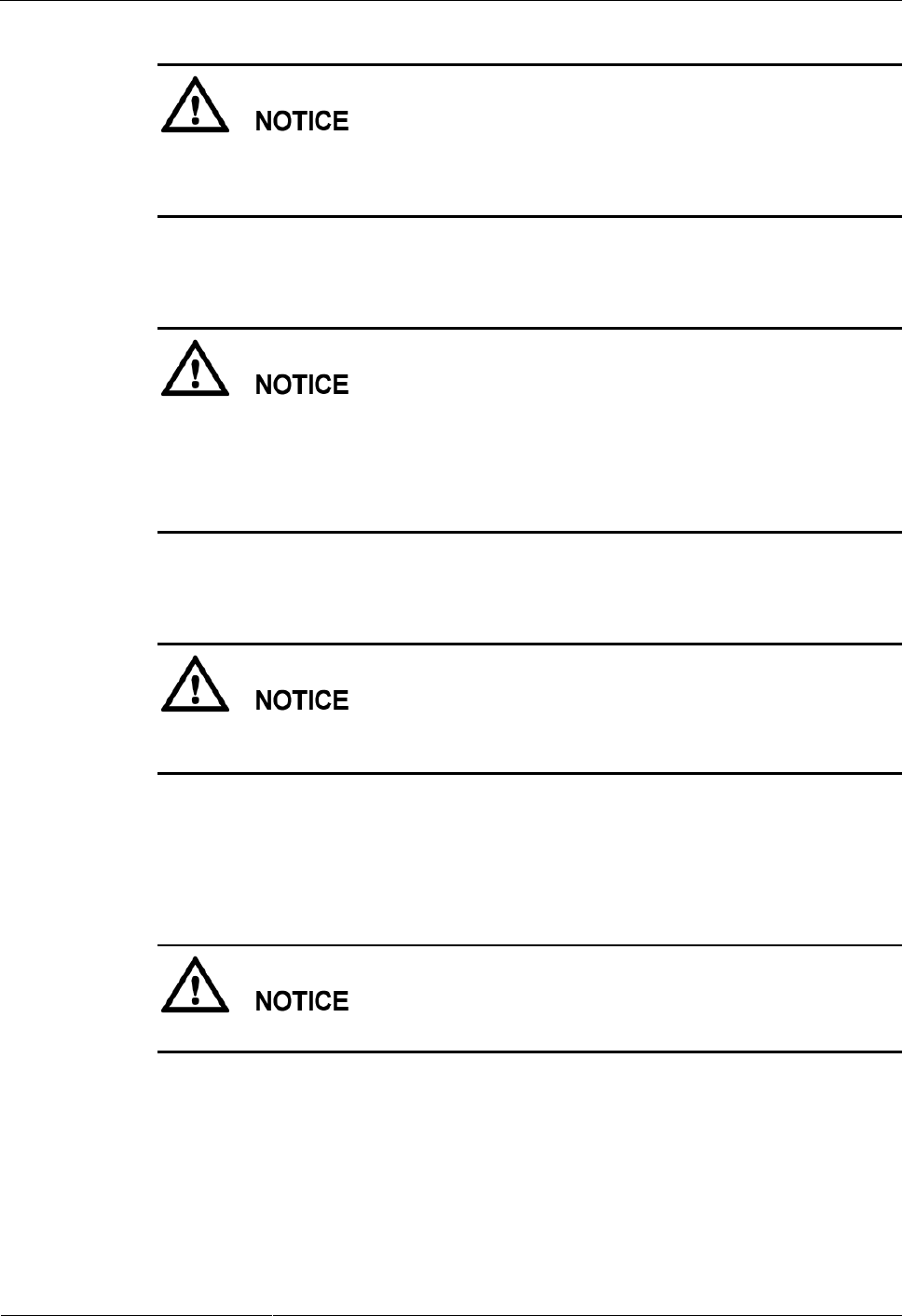
OptiX RTN 360 Radio Transmission System
Compliance and Safety Manual
3 Safety
Issue 02 (2014-08-30)
Huawei Proprietary and Confidential
Copyright © Huawei Technologies Co., Ltd.
13
Keep away metal objects, which may cause battery short circuit, from batteries. If metal
objects must be used, first disconnect the batteries in use before performing any other
operations.
Hazardous Gas
Do not use unsealed lead acid storage batteries. Lead acid storage batteries must be placed
horizontally and stably to prevent the batteries from releasing flammable gas, which may
cause fire or erode the device.
Lead acid storage batteries in use emit flammable gas. Therefore, ventilation and
fireproofing measures must be taken at the sites where lead acid storage batteries are used.
Battery Temperature
If a battery overheats, the battery may be deformed or damaged, and the electrolyte may
overflow.
When the temperature of the battery is higher than 60℃, check the battery for electrolyte
overflow. If the electrolyte overflows, absorb and counteract the electrolyte immediately.
Battery Leakage
When the electrolyte overflows, absorb and counteract the electrolyte immediately.
When moving or handling a battery whose electrolyte leaks, note that the leaking electrolyte
may hurt human bodies. When you find the electrolyte leaks, use the following substances to
counteract and absorb the leaking electrolyte:
Sodium bicarbonate (baking soda): NaHCO3
Sodium carbonate (soda): Na2CO3
Select a substance to counteract and absorb the leaking electrolyte according to the
instructions of the battery manufacturer.
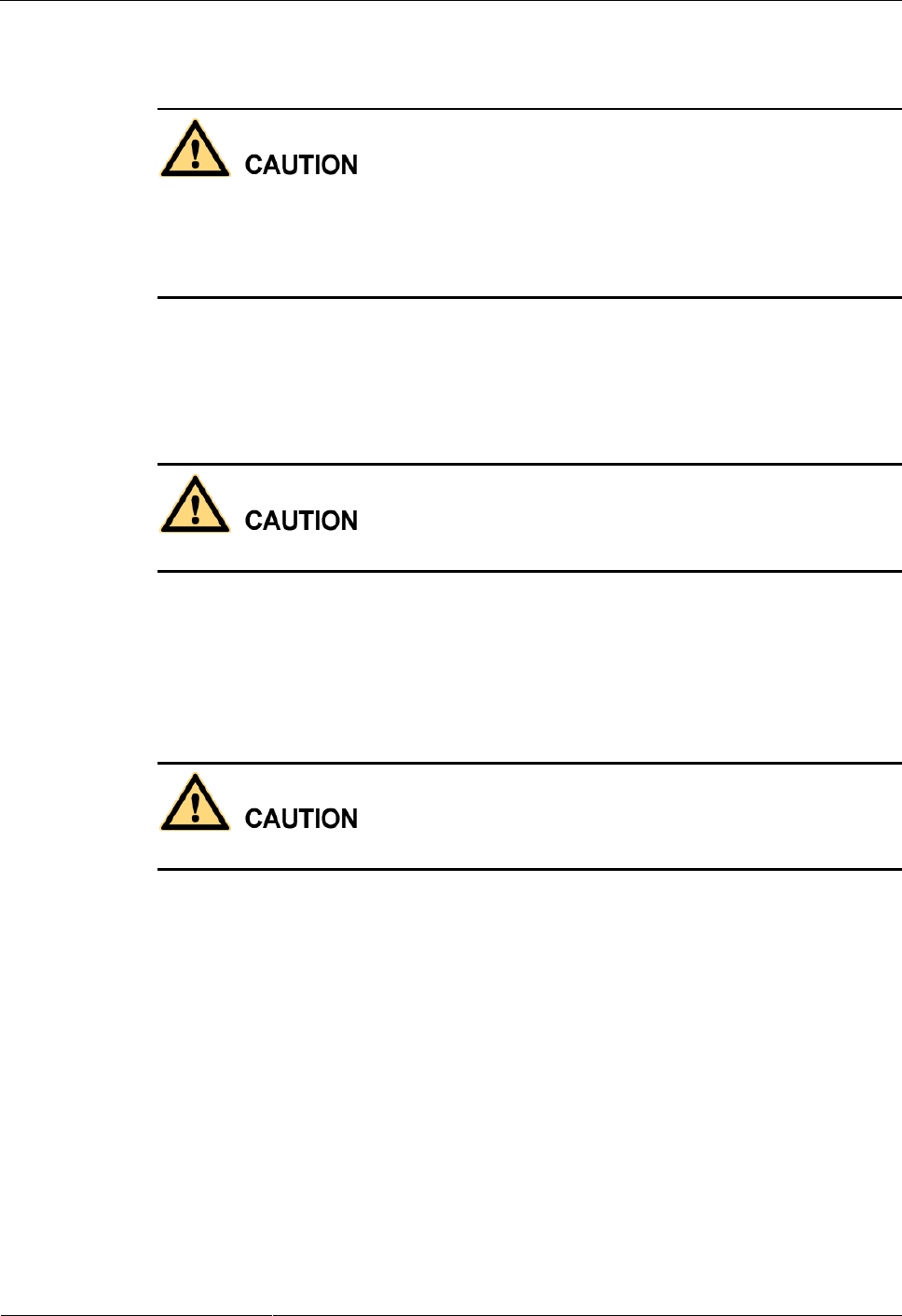
OptiX RTN 360 Radio Transmission System
Compliance and Safety Manual
3 Safety
Issue 02 (2014-08-30)
Huawei Proprietary and Confidential
Copyright © Huawei Technologies Co., Ltd.
14
Lithium Battery
There is danger of explosion if the battery is incorrectly replaced. Therefore, replace the
battery only with the same or equivalent type recommended by the manufacturer.
Exhausted lithium ion batteries must be disposed of according to the instructions.
Do not throw lithium ion batteries into fire.
3.1.5 Radiation
Electromagnetic Field Exposure
Radio-frequency signals with high intensity are harmful to human body.
Before installing or maintaining an antenna on a steel tower or a mast with a large number of
transmitter antennas, coordinate with the parties concerned to shut down the transmitter
antennas.
3.1.6 Working at Heights
Avoid object falling when you work at heights.
When working at heights, fulfill the following requirements:
Only trained personnel can work at heights.
Prevent the devices and tools that you carry from falling down.
Take safety and protection measures, for example, wear a helm and safety belt.
Wear warm clothes when working at heights in a cold region.
Before working at heights, check that all the lifting facilities are in good condition.
Hoisting Heavy Objects
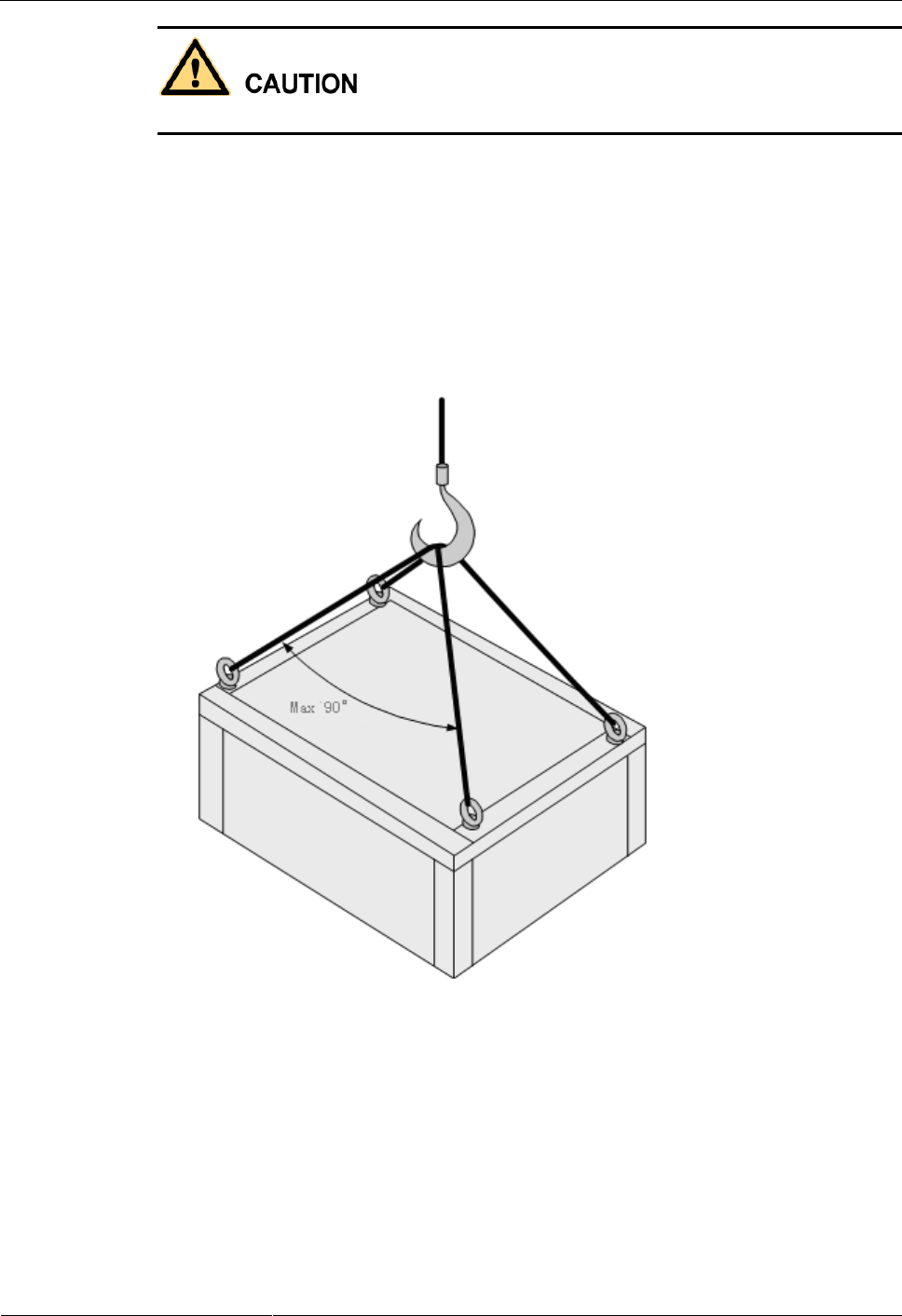
OptiX RTN 360 Radio Transmission System
Compliance and Safety Manual
3 Safety
Issue 02 (2014-08-30)
Huawei Proprietary and Confidential
Copyright © Huawei Technologies Co., Ltd.
15
Do not walk below the cantilever or hoisted objects when heavy objects are being hoisted.
Only trained and qualified personnel can perform hoisting operations.
Before hoisting heavy objects, check that the hoisting tools are complete and in good
condition.
Before hoisting heavy objects, ensure that the hoisting tools are fixed to a secure object
or wall with good weight capacity.
Issue orders with short and explicit words to avoid misoperations.
Ensure that the angle formed by two cables is not larger than 90 degrees. See Figure 3-1.
Figure 3-1 Hoisting heavy objects
Using Ladders
Checking a Ladder
Before using a ladder, check whether the ladder is damaged. Only the ladder in good
condition can be used.
Before using a ladder, you should know the maximum weight capacity of the ladder.
Avoid overweighing the ladder.
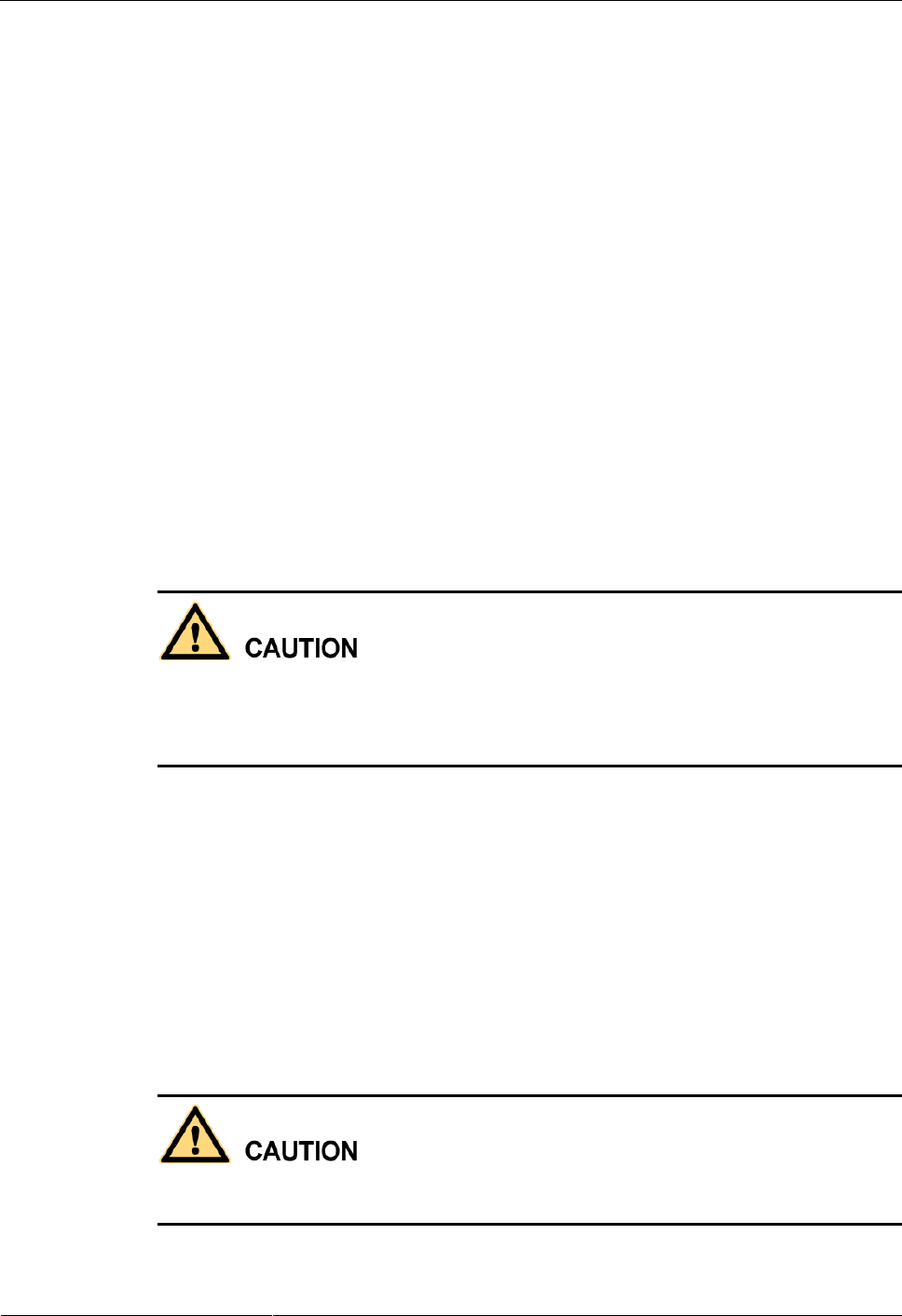
OptiX RTN 360 Radio Transmission System
Compliance and Safety Manual
3 Safety
Issue 02 (2014-08-30)
Huawei Proprietary and Confidential
Copyright © Huawei Technologies Co., Ltd.
16
Placing a Ladder
The recommended gradient of ladders is 75 degrees. You can measure the gradient of the
ladder with an angle square or your arms. When using a ladder, ensure that the wider feet of
the ladder are downward, or take protection measures for the ladder feet to prevent the ladder
from sliding. Ensure that the ladder is placed securely.
Climbing Up a Ladder
When climbing up a ladder, note the following:
Ensure that the center of gravity of your body does not deviate from the edges of the two
long sides.
To minimize the risk of falling, hold your balance on the ladder before any operation.
Do not climb higher than the fourth rung of the ladder (counted from up to down).
If you want to climb up a roof, ensure that the ladder top is at least one meter higher than
the roof.
3.1.7 Mechanical Safety
Drilling Holes
Do not drill the cabinet at will. Drilling holes without complying with the requirements affects
the electromagnetic shielding performance of the cabinet and damages the cables inside the
cabinet. In addition, if the scraps caused by drilling enter the cabinet, the printed circuit
boards (PCBs) may be short circuited.
Before you drill a hole in the cabinet, wear insulated gloves and remove the internal
cables from the cabinet.
Wear an eye protector when drilling holes. This is to prevent your eyes from being
injured by the splashing metal scraps.
Ensure that the scraps caused by drilling do not enter the cabinet.
Drilling holes without complying with the requirements affects the electromagnetic
shielding performance of the cabinet.
After drilling, clean the metal scraps immediately.
Sharp Objects
Before you hold or carry a device, wear protective gloves to avoid getting injured by sharp
edges of the device.
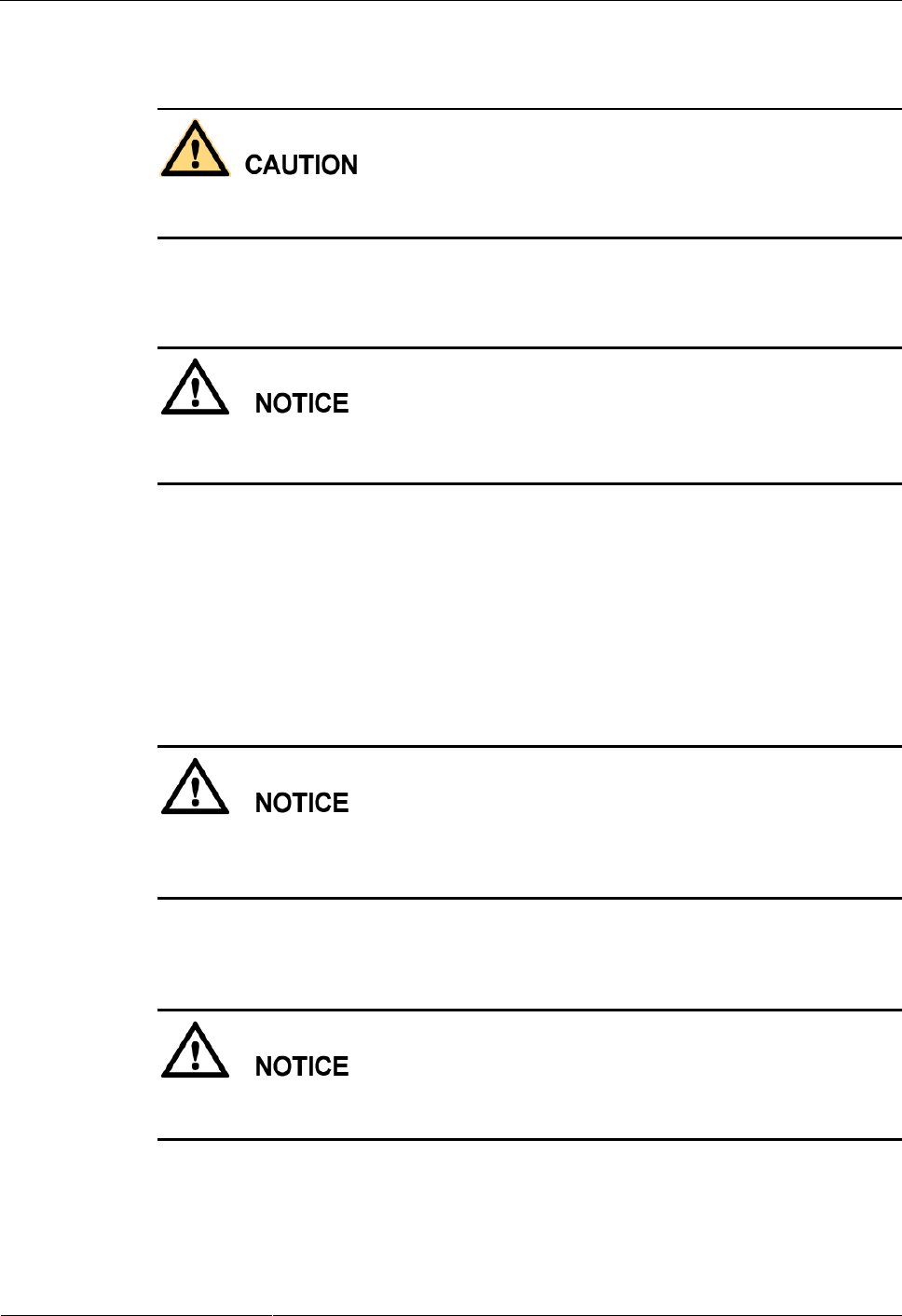
OptiX RTN 360 Radio Transmission System
Compliance and Safety Manual
3 Safety
Issue 02 (2014-08-30)
Huawei Proprietary and Confidential
Copyright © Huawei Technologies Co., Ltd.
17
Lifting Heavy Objects
When heavy objects are being lifted, do not stand or walk under the cantilever or the lifted
object.
3.1.8 Bundling Signal Cables
Do not bundle signal cables with high current cables or high voltage cables.
Maintain a minimum space of 150 mm between adjacent ties.
3.2 Equipment Safety
3.2.1 Electricity Safety
Thunderstorm
During thunderstorms, the electromagnetic field generated in the thunderstorm area may
damage the electronic parts. To prevent damage to the device during lightning, ground the
device properly.
High Electrical Leakage
If the "high electrical leakage" tag is present on the power terminal of the device, you must
ground the device before powering it on.
3.2.2 Electrostatic Discharge
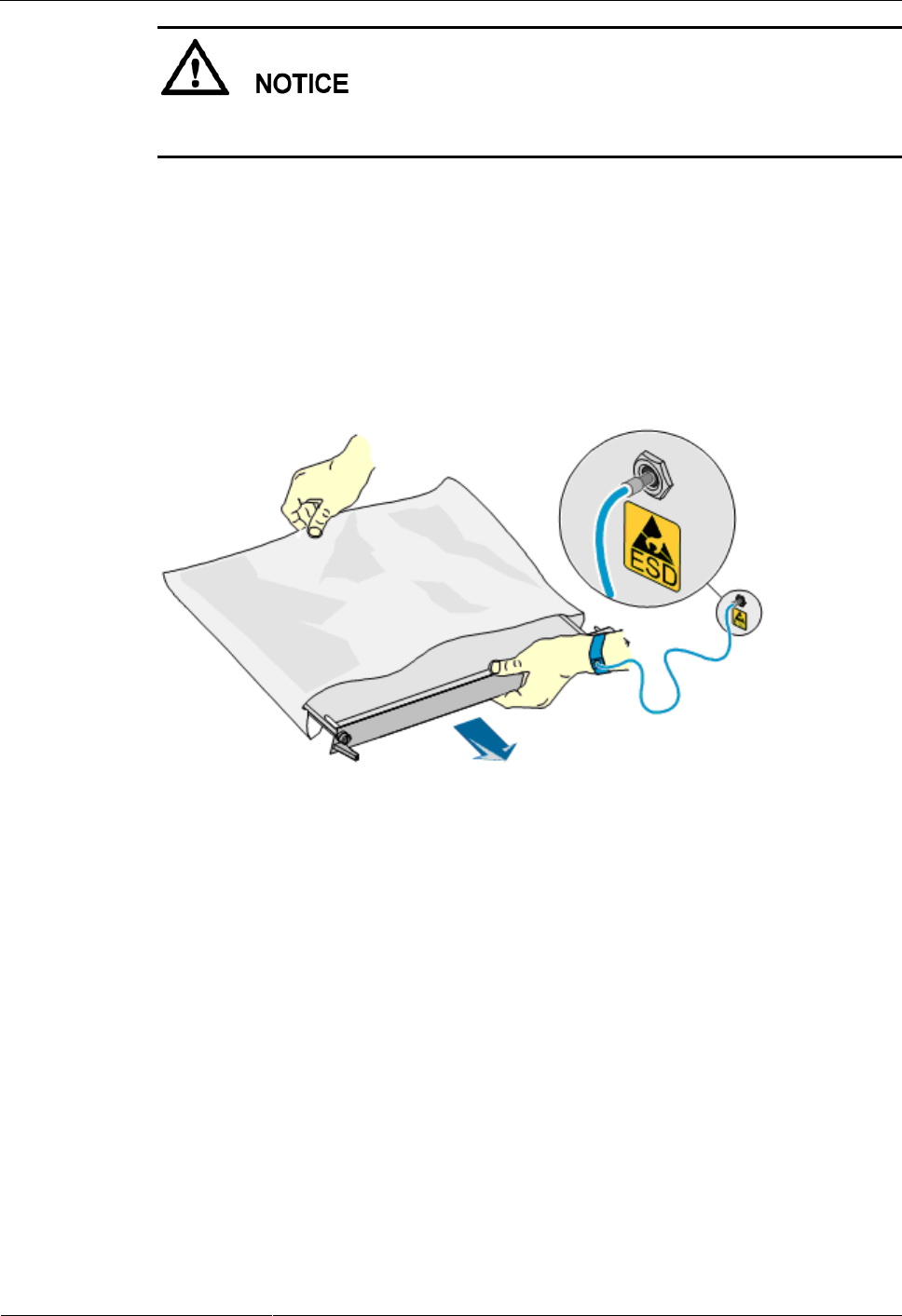
OptiX RTN 360 Radio Transmission System
Compliance and Safety Manual
3 Safety
Issue 02 (2014-08-30)
Huawei Proprietary and Confidential
Copyright © Huawei Technologies Co., Ltd.
18
The static electricity generated by human bodies may damage the electrostatic-sensitive
components on boards, for example, the large-scale integrated (LSI) circuits.
Human body movement, friction between human bodies and clothes, friction between shoes
and floors, or handling of plastic articles causes static electromagnetic fields on human bodies.
These static electromagnetic fields cannot be eliminated until the static is discharged.
To prevent electrostatic-sensitive components from being damaged by the static on human
bodies, you must wear a well-grounded ESD wrist strap when touching the device or handling
boards or application-specific integrated circuits (ASICs).
Figure 3-2 shows how to wear an ESD wrist strap.
Figure 3-2 Wearing an ESD wrist strap
3.2.3 Laying Cables
When the temperature is very low, violent strike or vibration may damage the cable sheathing.
To ensure safety, comply with the following requirements:
Cables can be laid or installed only when the temperature is higher than 0℃.
Before laying cables which have been stored in a temperature lower than 0℃, move the
cables to an environment of the ambient temperature and store them at the ambient
temperature for at least 24 hours.
Handle cables with caution, especially at a low temperature. Do not drop the cables
directly from the vehicle.

OptiX RTN 360 Radio Transmission System
Compliance and Safety Manual
3 Safety
Issue 02 (2014-08-30)
Huawei Proprietary and Confidential
Copyright © Huawei Technologies Co., Ltd.
19
3.3 Electromagnetic Field Exposure
Introduction
The Microwave equipment emits Radio Frequency (RF) radiation. Follow the local safety
regulations when installing and operating The Microwave equipment to avoid radiation
hazard.
Guidelines on Limiting Exposure to Electromagnetic Fields
There are a number of international regulations, standards, and guidelines for exposure to
electromagnetic fields. Some European countries have adopted the recommendation of the
council of the European Union (1999/519/EC), released on July 12, 1999, focusing on the
hazards of exposure to electromagnetic fields. The recommendation is based on the guideline
published by the International Commission on Non-Ionizing Radiation Protection (ICNIRP).
Table 3-1 lists the regulations and reference levels applied in different countries.
Table 3-1 Electromagnetic regulations and references (examples for operating frequencies of The
Microwave equipment)
Country
Limit 60GHz E Electric
Field Strength
Limit 60GHz S Power
Flux Density
ICNIRP International
61 V/m
10 W/m2
Europe (1999/519/EC)
61 V/m
10 W/m2
Reference levels are provided for exposure assessment, that is, to determine whether the
minimum limit of human exposure to electromagnetic fields is exceeded. The minimum limit
on exposure to electromagnetic fields is based on established health effects and biological
considerations.
Location of Base Station Antennas
The Microwave equipment, the source of the radiation, are usually mounted:
On freestanding towers, with a height up to 30 m
On a tower on the top of buildings
To the side of buildings, on rare occasions
Generally, the antenna cannot be located in a position lower than 10 m. The energy usually
forms a horizontal main beam and is slightly tilted downwards. The remaining energy forms
into weaker beams on both sides of the main beam. The main beam, however, does not reach
the ground if the antenna is around 50–200 m away from the ground.
The highest level of emission would be expected in close vicinity of the antenna and in line of
sight to the antenna.
Exclusion Zones
The requirements for exclusion zones are as follows:

OptiX RTN 360 Radio Transmission System
Compliance and Safety Manual
3 Safety
Issue 02 (2014-08-30)
Huawei Proprietary and Confidential
Copyright © Huawei Technologies Co., Ltd.
20
The antenna should be properly located to prevent the public from accessing the area
where the RF radiation exceeds the previously mentioned limits.
If areas with excessive RF radiation are accessible to the operation and maintenance
(O&M) personnel, ensure that they know the source of radiation and can power off or
shut down the transmitters before entering high radiation areas. In addition, such areas
must be confined within a distance of 10 m from the antennas.
Each exclusion zone should be defined by a physical barrier and by a recognizable sign
warning the public or O&M personnel.
Guidelines on Choosing Antenna Sites
The guidelines on choosing the antenna sites are as follows:
For roof-mounted antennas, raise the antennas above the height of the personnel who
may have to work on the rooftop.
For roof-mounted antennas, keep the transmitter antennas away from the areas accessible
to the public, such as roof access points, telephone service points, and HVAC devices.
For roof-mounted directional antennas, place the antennas near the periphery, and do not
make the antennas face the building.
Consider the trade-off between large aperture antennas (lower maximum RF) and small
aperture antennas (lower visual impact).
Keep higher-power antennas away from accessible areas.
Keep the antennas in a site that is far away from urban areas, though this may contradict
the coverage area requirements.
Exercise extra caution when designing co-location sites, that is, antennas owned by
different companies are located in the same site or are co-sited. This applies particularly
to sites that include high-power broadcast (FM/TV) antennas. Local zone often favors
co-location, but co-location may cause safety problems.
Take special precautions for antenna sites near hospital and schools.
Location of The Microwave equipment
The Microwave equipment is shielded from RF radiation hazards. The device has been tested
to comply with the radioactive spurious emission requirements of international standards or
local regulations. Therefore, the Microwave equipment under normal operating conditions
does not cause danger to the public and O&M engineers. However, the limits for RF radiation
might be exceeded due to faulty antenna cables or for other causes.
Microwave equipment sites shall not be accessible to the public. Only authorized and
trained personnel can access Microwave equipment sites or equipment rooms.
A sign of excessive RF radiation must be present on the doors of the sites or equipment
rooms to warn the personnel inside the site or equipment room of excessive RF radiation.
Microwave equipment sites must be regularly monitored and inspected after installation.
Prediction of the Exposure to Electromagnetic Fields
This section provides a theoretical approach to calculate possible exposure to electromagnetic
radiation around a Microwave equipment antenna. Precise statements are possible either with
measurements or complex calculations considering the complexity of the environment, such
as soil conditions, nearby buildings and other obstacles. The complexity may cause reflection,
deflection, and scattering of electromagnetic fields.

OptiX RTN 360 Radio Transmission System
Compliance and Safety Manual
3 Safety
Issue 02 (2014-08-30)
Huawei Proprietary and Confidential
Copyright © Huawei Technologies Co., Ltd.
21
The maximum output power (given in EIRP) of a BTS is usually limited by license conditions
of the network operator.
A rough estimation of the expected exposure in power flux density on a given point can be
made with the following equation:
S = (P(W) x Gnumeric)/(4 x r²(m) x π)
Where,
P = Maximum output power at antenna port of the Microwave equipment in W
Gnumeric = Numeric gain (see below)
r = Distance between the antenna and the point of exposure in meters
For the calculation of the Gnumeric,
Gnumeric = 10GdB/10
GdB = Gantenna(dB) – Bcable(dB) – Bvertical-attenutation(dB) – Bhorizontal-attenuation(dB)
B = attenuation in dB